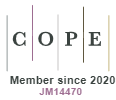Cross training: perceptions of parents and children that practice the modality: pilot study
DOI:
https://doi.org/10.5585/23.2024.26644Keywords:
Cross training, Cross fit, Exercises, Child, ParentsAbstract
Introduction: The positive effects of physical activity on children and adolescents have been widely researched, pointing out consistent indications significantly playful and pleasurable experiences.
Objective: to analyze the perceptions of parents and children who practice Cross training.
Methodology: semi-structured interviews were carried out with 10 children and 10 parents attending cross training (CT) program in training. For data analysis, the responses were transcribed, grouped by approximation in order to identify the most representative words.
Results: for parents, the indication of physical activity, health and quality of life were the main reasons for placing their child in CT. In relation to children, getting healthy, strong and losing weight were the only conditions presented, however, performing playful exercises, with barbell, paddle and ball were the most indicate activities.
Conclusion: we noticed an emphasis on the search for health and quality of life as the main reason for parents choosing the modality for their children's participation in CT. The playful activities carried out were highlighted as the favorites of participating children who seek to become strong and healthy through practice
Downloads
References
Oliveira ARC, Santos ALB, Aguiar JB, Franchi KMB, Pontes Junior JAF. Atividade física e promoção da saúde na escola: coletânea de estudos. 2017
Weinberg RS, Gould D. Fundamentos da psicologia do esporte e do exercício. Vol. 6. Artmed; 2016.
Organização Mundial da Saúde. Guidelines on physical activity, sedentary behavior and sleep for children under 5 years of age. 2019.
Zick L. EF Deportes.com. 2015. Atividade física e saúde, conceitos e benefícios.
Corrêa FB, Santos IP, Fangundes DS. Treinamento Funcional no Brasil – Origens e Benefícios. Ariquemes. 2018;1(12):232–40.
Gravazzi M, Dorst DBG. A origem do cross training e sua evolução. Em: Anais do 12o Encontro Científico Cultural Interinstitucional. 12o ed 2014. p. 1–9.
Marin JLDO, Alencar GP De, Lima LEM, Teixeira CVLS, Silva A. Treinamento funcional na infância: o que pensam os pais e as crianças? Rev Bras Fisiol Exerc. 2019;18(1):17–22.
Faria BB, Costa C, Bernardes CR. Educação Física e atividade lúdica: O papel da ludicidade no desenvolvimento Infantil. Revista Científica Multidisciplinar Núcleo do Conhecimento. 2016;1(9):136–55.
Minayo MCS, Sanches O. Quantitativo-qualitativo: oposição ou complementaridade? Cad Saúde Púb. 1993;9(3):239–62.
Triviños NSA. Introdução à pesquisa em ciências sociais. a pesquisa qualitativa em educação. Atlas; 1987.
Barrachina V, Marcen C, Mainer-Pardos E., Arbones-Arque I. Proximity sports as a sustainable strategy for the promotion of physical activity at an early age: The KIA project. Sustainability 2023; 15: 12043.
Oliveira AR, Lopes AG, Risso S. Elaboração de programas de treinamento de força para crianças. Semin. Cienc. Biol. Saúde [Internet]. 15º de julho de 2004 [citado 13º de agosto de 2024;24(1):85-96.
Santos SC & Knijnik JD. Motivos de adesão à prática de atividade física na vida adulta intermediária. Revista Mackenzie de Educação Física e Esporte, 2006; 5(1): 23-34.
Silva MC, Rombaldi AJ, Azevedo MR, Hallal PC. Participação atual e passada em academias de ginástica entre adultos: prevalência e fatores associados. Rev. Bras. Ativ. Fís. Saúde 2012; 13(1):28-36.
Rojas PNC. Aderência aos Programas de exercícios físicos em academias de ginástica na cidade de Curitiba – PR. 2003. Dissertação (Mestrado EM Educação Física), Universidade Federal de Santa Catarina, Florianópolis.
Tahara AK; Schwartz GM, Silva KA. Aderência e manutenção da prática de exercícios em academias. Revista Brasileira Ciência e Movimento, 2003; 11(4): 7-12.17. Sanseverino MA, Weide JN, Silberfarb MS. Influência da família na atividade física decrianças e adolescentes: revisão Integrativa da Literatura. Brazilian Journal of Health Review, 2022; 5(2): 4578-4594.
Carvalho AS, Abdalla PP, Silva NGF, Garcia Junior JR, Mantovani AM, Ramo NC. Exercício físico e seus benefícios para a saúde das crianças: uma revisão narrativa. Revista CPAQV – Centro de Pesquisas Avançadas em Qualidade de Vida, 2021; 13 (1), 2-15.
RossiI CE, Correa EN, Neves J, Gabriel CG, Benedet J, Rech CR, Vasconcelos FAG. Body mass index and association with use of and distance from places for physical activity and active leisure among schoolchildren in Brazil. Cross-sectional study. Sao Paulo Med J. 2018; 136(3): 228-236.
Mello MT de, Boscolo RA, Esteves AM, Tufik S. O exercício físico e os aspectos psicobiológicos. Rev Bras Med Esporte. 2005;11(3):203–7.
Downloads
Published
How to Cite
Issue
Section
License
Copyright (c) 2024 Alexsander O. Santos, Rodrigo Paiva, Carlos H. O. Reis , Alexandre F. Machado, Ana Paula Lima-Leopoldo, Ana Claudia S. Nascimento, Danilo Bocalini, Roberta Luksevicius Rica

This work is licensed under a Creative Commons Attribution-NonCommercial-ShareAlike 4.0 International License.
- Abstract 118
- PDF (Português (Brasil)) 57






